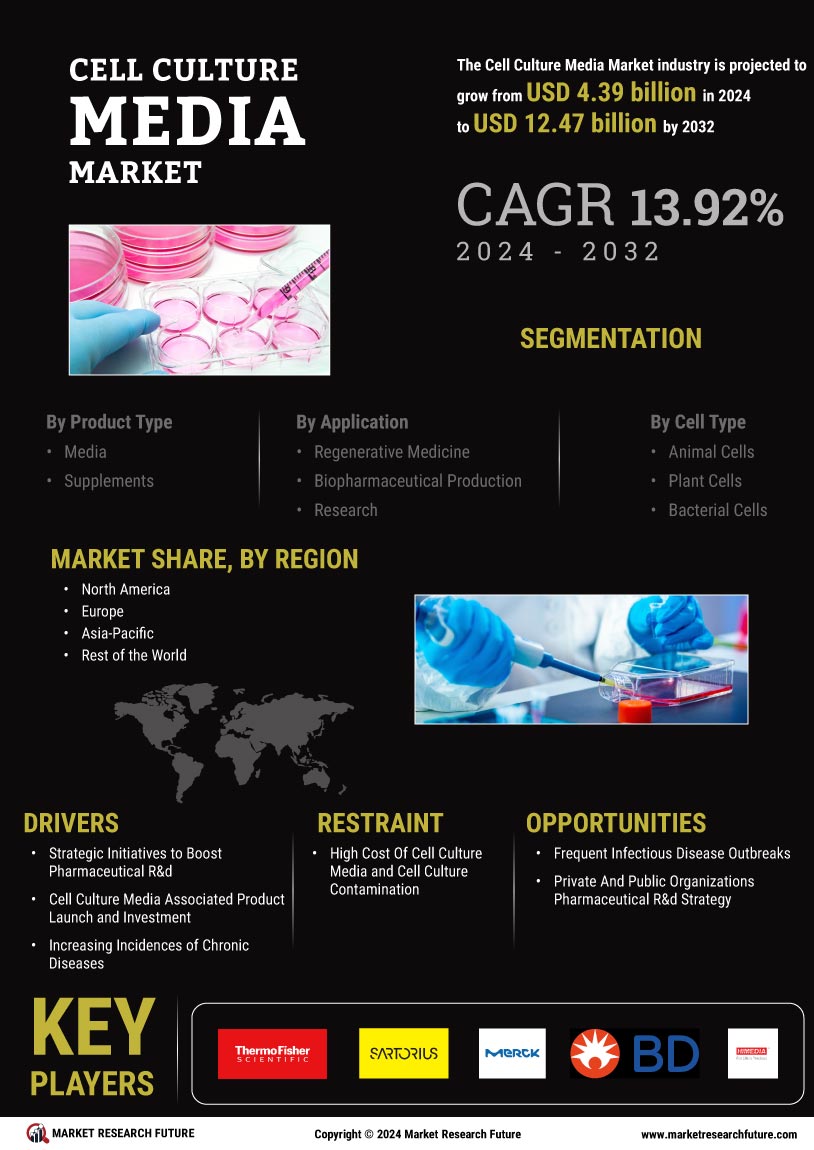Rising Demand for Biopharmaceuticals
The increasing demand for biopharmaceuticals is a primary driver of the Cell Culture Media Market. As the healthcare sector continues to evolve, the need for innovative therapies, including monoclonal antibodies and vaccines, has surged. This trend is reflected in the projected growth of the biopharmaceutical market, which is expected to reach approximately USD 500 billion by 2025. Consequently, the Cell Culture Media Market is experiencing heightened demand for specialized media formulations that support the production of these complex biological products. The need for high-quality, reliable cell culture media is paramount, as it directly impacts the yield and efficacy of biopharmaceutical production. This growing market segment is likely to drive investments in research and development, further enhancing the capabilities of cell culture media formulations.
Increased Focus on Personalized Medicine
The shift towards personalized medicine is reshaping the landscape of the Cell Culture Media Market. As healthcare providers increasingly recognize the importance of tailoring treatments to individual patient profiles, the demand for cell culture media that can support personalized therapies is on the rise. This trend is particularly evident in oncology, where patient-specific tumor cells are cultured to test drug responses. The market for personalized medicine is anticipated to reach USD 2 trillion by 2025, which will likely drive the need for innovative cell culture media formulations. These formulations must be adaptable and capable of supporting diverse cell types and conditions, thereby fostering the growth of the Cell Culture Media Market as it aligns with the broader trend of personalized healthcare.
Advancements in Cell Culture Technologies
Technological advancements in cell culture techniques are significantly influencing the Cell Culture Media Market. Innovations such as 3D cell culture systems and bioreactor technologies are enhancing the efficiency and scalability of cell culture processes. These advancements allow for more accurate modeling of in vivo conditions, which is crucial for drug development and toxicity testing. The market for 3D cell culture is projected to grow at a compound annual growth rate of over 25% in the coming years, indicating a robust shift towards more sophisticated cell culture methodologies. As researchers and companies adopt these technologies, the demand for specialized cell culture media that can support these advanced systems is likely to increase, thereby propelling the growth of the Cell Culture Media Market.
Growing Investment in Regenerative Medicine
Investment in regenerative medicine is emerging as a significant driver for the Cell Culture Media Market. As research into stem cell therapies and tissue engineering advances, the need for specialized cell culture media that can support the growth and differentiation of stem cells is becoming increasingly critical. The regenerative medicine market is projected to exceed USD 100 billion by 2025, highlighting the potential for growth in this sector. This surge in investment is likely to stimulate demand for high-quality cell culture media that can facilitate the development of effective regenerative therapies. Consequently, the Cell Culture Media Market is expected to benefit from this influx of funding and research activity, leading to the development of innovative media solutions tailored for regenerative applications.
Regulatory Support for Cell Culture Applications
Regulatory support for cell culture applications is playing a pivotal role in the growth of the Cell Culture Media Market. Governments and regulatory bodies are increasingly recognizing the importance of cell culture technologies in drug development and safety testing. This recognition is leading to streamlined approval processes and guidelines that encourage the use of cell culture methods over traditional animal testing. As regulatory frameworks evolve, the demand for compliant and effective cell culture media is likely to increase. The Cell Culture Media Market stands to benefit from this trend, as companies seek to align their products with regulatory standards while ensuring the efficacy and safety of their cell culture processes. This supportive regulatory environment is expected to foster innovation and growth within the industry.


















Leave a Comment